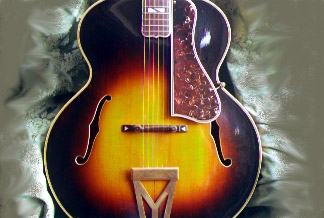
The Playmate of the month
Gibson Super 400, 1934

Since its introduction in 1934, the Super 400 ranks at the top of Gibson's archtop line. Even rarer, and more glamorous, than the famous L5, it has grown along with guitar-design and american music history, following and reflecting ups and downs of the Kalamazoo-based brand: with its eighteen inches of width, fantastic woods and rich mother-of-pearl inlays, great attention paid to little details and a powerful sound, it was a knock-out answer to competitors: Epiphone was going fast on the new ground of archtop guitars with its own new line, and Gibson answered by redesigning already popular models such as L5, L7, L12, that guaranteed with their new 17-inch body more 'cutting power' in the big band ensemble music of the time. But the Super 400 was something different: not only it was the most powerful and spectacular guitar that Gibson had ever issued in its current production, but it was an eulogy to richness, luxury and beauty, which could exorcize Depression's Evil Spirit that held America into its vice.
 |
With
a price of 400 dollars including leather hardshell case
(a '34 L5 had a list price of $275) it was a symbol of
optimism, and trust in recovery: and it was definetely a
'serious' instrument, conceived for professional
musicians. At the time of its introduction, it had no
rivals, but Epiphone soon replied with the colossal
Emperor model; John D'angelico created his first 18-inch
NewYorker in the Kenmare Steet shop, and Elmer Stromberg
build his nineteen-inch monsters... But with its beauty
and balanced sound, Gibson Super 400 remained the
standard by which other instruments were judged. In 1937 the upper bouts became a little larger, the f-holes got longer, and the original 24 3/4" scale was lenghtened to the classic 25 1/2" scale. A cutaway model, named Super 400 Premier was introduced in 1939, and in that same year the new blond finish was offered beside the traditional sunburst. The electric 'CES' version, another Gibson classic, was introduced in 1951, and since then it has always remained in production, mostly in small quantities or on a custom-order basis. |
Many famous musicians have tied to the Super 400 the happiest years of their career. Even though the guitar was conceived as a jazz or dance-bands instrument, it was embraced by artists as different as guitarist-violinist-singer Muzzy Marcellino, Les Paul (then nicknamed Rubharb Red), Harry Volpe, Roy Rogers, Merle Travis, Kenny Burrell , Larry Coryell. From country to swing, from cool to fusion, Super 400 has enrichened with timbric complexity and beauty the music that saw it as a protagonist.
But how much does a Super 400 worths today in the vintage market? Well, it's expensive. It won't be easy for you to find a '40s full-body Super 400 for less than 7.500/8.000 dollars, and an early cutaway for less than 10.000... If you find some, please let me know!
The first one ever produced bore a 'Deluxe L5' label inside, and a 'Super L5' on the truss rod cover, and it belonged to Tony Romano, who worked for a long time with Bob Hope; probably the second Super 400 was the one owned by Muzzy Marcellino, at the time singer with Ted Fio Rito band("I'll String Along With You").
| The Gibson Super 400 that Real Vintage is showing to you has serial number 92115, and it is one of the very first 400s built in 1934, the model's first year of production. It still has the 'short' 24 3/4" scale, and smaller upper bouts. An interesting feature is the fretboard wood, which is rosewood instead of standard ebony, and we know of other '34 Super 400s with that same peculiarity. Even the bridge is inlaid with two small triangular pieces of pearl, and the gold-plated tailpiece is engraved with the model's name, which we also find on the plastic neck-heelcap. The tuners, also gold-plated, are Grover Sta-Tites similar to the ones mounted on '30s L5, but engraved. The body has a five-ply binding, and fretboard and f holes have are three-ply bound. The x-braced, close grain spruce top is deeply carved, and so is the two piece back, which has a beautiful and rich flamed figure, like maple neck and sides.I | 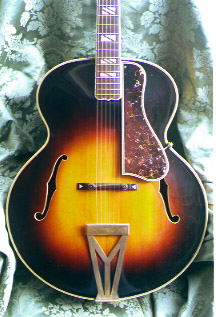 |
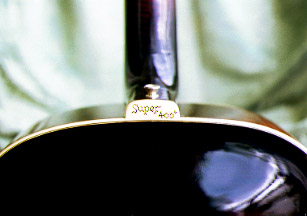 |
Gibson Super 400, for its conspicuous dimensions and large shape, could hold you in awe at first, but this feeling will be easily forgotten at the ringing of the first notes, that reveal a complex but not difficult guitar, which can surprise you with its volume and sweetness. A guitar born to be heard amoung honking saxophones, which nevertheless can express itself in a sophisticated language made of chromatic richness and high lutherie in a more cozy and thoughtful context. |
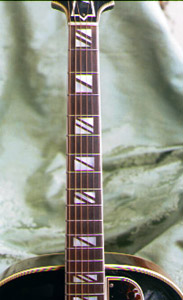 |
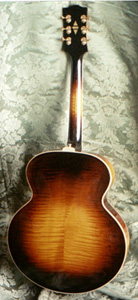 |
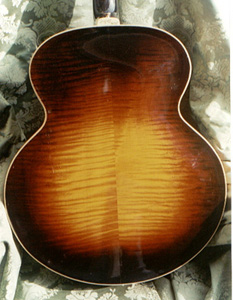 |
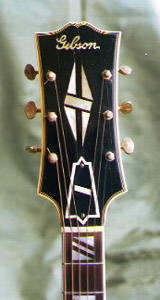 |